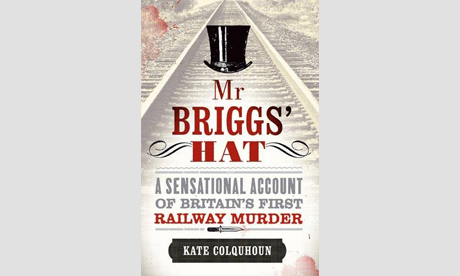Mr Briggs’ Hat: A Sensational Account of Britain’s First Railway Murder by Kate Colquhoun – review
Kate Summerscale scored a bestseller with her elegant account of a sensational mid-Victorian murder, The Suspicions of Mr Whicher. Now, here’s an account of an almost equally sensational mid-Victorian murder, also with the word "Mr" in the title, also written by an author called Kate – circumstances tending to arouse in the present reviewer what might be called "The Suspicions of Mr Martin". Is this a proper book or a naked cash-in?
It’s true that, unlike the country house murder investigated by Jack Whicher, the killing of 69-year-old Thomas Briggs in a first-class compartment of a North London Railway train on the evening of 9 July 1864 has not often been chronicled at length (even if it does rate a mention in most accounts of Victorian train travel). But at first I thought that Colquhoun was aiming at the bestseller lists with a piece of pure hackery. Early on, there’s a pretty vacuous account of the rise of the railways. They spread news of national and international events to "the very edges of the country", would you believe? And in setting the scene of the killing, she writes: "Like most English locomotives at the time, each varnished teak carriage of the North London Railway train was divided into separate, isolated compartments," suggesting she has not absorbed the fairly elemental fact that the locomotive is the engine at the front of the train. (Later, Euston main line station is repeatedly referred to as "Euston Square", which is what the adjacent Underground station came to be called in 1909).
But as Mr Briggs makes his last peregrinations, I began to be drawn in. The particular, dreamy character of this murder is informed by the fact that it happened within the professional context of the City of London, yet on a summer Saturday. Mr Briggs – a senior bank clerk – worked on Saturdays, but only until 3pm. We meet him on Saturday morning, walking from Fenchurch Street station, terminus of the North London Railway, to his office in Lombard Street "under a warming sky filled with clouds smudged by greasy smog". After work, he takes a bus to Peckham in order to give a present to his niece. As he returns to the City in the evening, Colquhoun sketches in a low sun, and swallows wheeling in the sky. Besides writing with real forward momentum, she is good at atmosphere.
At Fenchurch Street, Briggs boarded the 9.45pm train that ought to have taken him to his home station: Hackney. But the train arrived at Hackney without Mr Briggs. Instead, there was a blood-soaked compartment containing what would prove to be Mr Briggs’ bag, his stick and a crushed hat that had not belonged to him. The ladies in the next door compartment discovered that their dresses had been stained with drops of blood, which had apparently flown through the window of the one compartment into the next. But nobody had heard anything. Later on that balmy evening, Mr Briggs was found, battered and dying – and minus his gold watch and chain – by the side of the tracks leading to Hackney.
Suspicion soon alighted on a young, down-at-heel German-born tailor called Franz Muller, and Mr Briggs’ Hat is a compelling read because innocent explanations are gradually posited for the following, apparently damning facts: that Muller was found in possession of Briggs’s watch and possibly his hat; that the hat left in the carriage was also traced to him; that he sailed to America just days after the killing.
Muller was slightly built, and – on the face of it – remarkably inoffensive. Important evidence against him arose from the fact that he kindly gave a jewellers’ branded cardboard box to the daughter of a friend to play with. The captain of the ship carrying him to America said that he was "one of the most agreeable passengers on board". When apprehended in New York by Detective Inspector Richard Tanner (who was from the same team of early detectives as Summerscale’s Jack Whicher), he mildly inquired: "What is the matter?" On the journey back to Britain, he was very grateful when Tanner gave him The Pickwick Papers to read, and he chortled over the legal entanglements of the hero.
Even though the killing of Briggs was a "stranger murder", about which an urbanised society was becoming increasingly paranoid, it lacked the social and class resonance of Whicher’s investigation. It did not, like that case, inspire some classic novels, but rather a sub-genre of crime stories concerning encounters with cads in railway compartments – a tide not stemmed by the introduction of communication cords. This was directly consequent upon the Muller case, as was the introduction, between compartments, of windows called Muller lights (which is now the name of a yoghurt, presumably so called by someone with little knowledge of railway history).
But this doesn’t matter. The point is that the weight of evidence is in the balance to the very end. Was a just verdict achieved? The answer, mesmerisingly enough, seems to be "not quite".
Andrew Martin’s latest novel is The Somme Stations (Faber)
guardian.co.uk © Guardian News & Media Limited 2010
Published via the Guardian News Feed plugin for WordPress.

